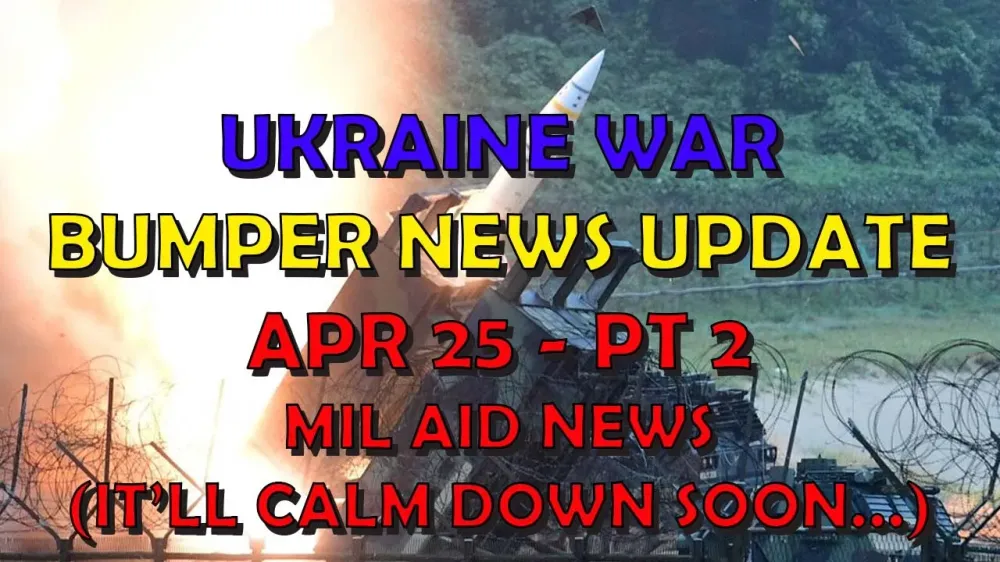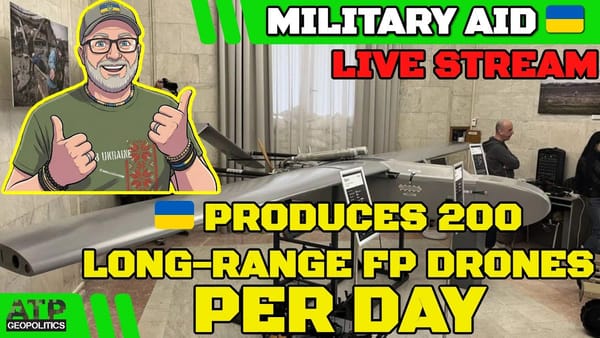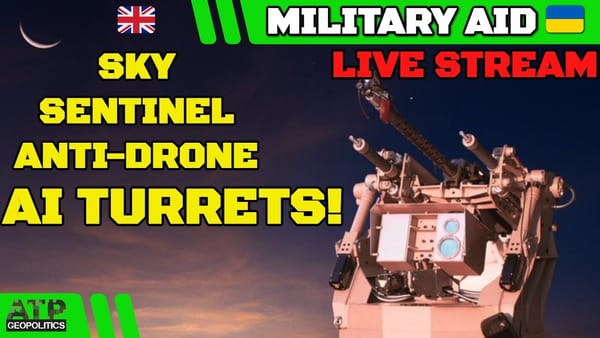Ukraine War Update ANOTHER BUMPER NEWS: Military Aid News
Table of Contents 📖
"The US aid package to Ukraine is actually…improving the US military. It is basically investing in the US military…and investing in the US military industrial complex…"
Hello Team
🎦 00:00-00:26⏩
Jonathan welcomes viewers to another Ukraine War News Update, focusing on military aid and equipment. He explains the need for a separate video due to the significant volume of news regarding aid to Ukraine.
Return to top⤴️
USA - Debunking the $60 Billion Military Aid Misinformation
🎦 00:26-07:39⏩
Jonathan addresses the misinformation spread by some American lawmakers, like Josh Hawley, regarding the $60 Billion US military aid package. He clarifies that the package does not equate to a direct $60 billion transfer to Ukraine.
- A substantial portion of the funding goes towards:
- Replenishing US stockpiles with upgraded equipment sent to Ukraine (approx. $13.41 billion).
- The Ukraine Security Assistance Initiative (USAI) for various support functions, including training, equipment, logistics, etc. (approx. $13.78 billion).
- This model benefits the US by:
- Modernising its military stockpiles.
- Stimulating the US economy and creating jobs by placing orders with US defence companies.
- Jonathan emphasizes that much of the aid is not a direct cost but an investment in the US Military Industrial Complex.
- He highlights the difference between the perceived value of equipment sent from existing US stockpiles and the actual cost of replenishing those supplies.
- Jonathan estimates the actual military aid to Ukraine to be closer to $25 billion, with a large portion indirectly benefiting the US.
USA - Secret Approval of ATACMS Missiles and Restrictions on Use
🎦 07:39-10:19⏩
- Jonathan discusses the revelation by Jake Sullivan, National Security Advisor, that the US secretly provided Ukraine with a "significant number" of ATACMS missiles.
- He notes that this follows Russia's use of North Korean ballistic missiles against Ukraine, indicating a possible response in kind.
- The ATACMS transfer was part of a $300 million aid package approved in March.
- Ukraine has reportedly already used these 300km range ATACMS missiles three times, suggesting they were part of a previous Presidential Drawdown Authority (PDA).
- Jonathan expresses disappointment with Sullivan's stipulation that these missiles cannot be used inside Russian territory, viewing it as a missed opportunity to target Russian launch sites in Belgorod that frequently shell Kharkiv.
Germany - Taurus Missiles: A Deterrent to Nuclear War?
🎦 10:19-16:09⏩
- Jonathan delves into the ongoing debate surrounding Germany's reluctance to supply Taurus cruise missiles to Ukraine.
- He discusses a theory proposed by a viewer, Sophie Dorian, suggesting that Germany might be holding back these missiles as a deterrent against a potential nuclear war.
- Sophie's argument posits that:
- Germany possesses over 600 Taurus missiles.
- In a nuclear conflict, these missiles could be used to target Russian nuclear silos before they launch, potentially mitigating a mass strike.
- Jonathan acknowledges this theory as a plausible rationale for Germany's hesitation, particularly since they are not a nuclear power. He points out that:
- Giving Taurus to Ukraine risks Russia capturing and reverse-engineering them, negating their effectiveness in a nuclear crisis.
- Germany's ability to counter a nuclear threat relies on this technology, not just the number of missiles, as they can always produce more.
- Jonathan invites viewers to share their thoughts on this theory.
Germany - Frustration over Lack of Support from Other European Nations on Military Aid
🎦 16:09-18:03⏩
Jonathan highlights the frustration expressed by German Defence Minister Boris Pistorius over the lack of support from other European nations in providing military aid to Ukraine.
- He points out Germany's significant contribution, stating that they've given more than any other nation in terms of military equipment.
- Jonathan criticizes media outlets like Sky News for their portrayal of Germany's stance, deeming it unfair. He emphasizes:
- Germany has doubled the UK's contributions in military aid.
- They are actively pressuring other nations to supply Patriots and are contributing another system themselves.
- Jonathan calls out countries like Greece, Spain, and France, who he believes could be doing more.
- He acknowledges France's challenges with the upcoming Olympics and the need to secure their air defence systems but believes other nations have the capacity to contribute more substantially.
Germany and UK - Joint Efforts to Support Ukrainian Helicopters
🎦 18:03-19:59⏩
- Jonathan reports on a joint agreement between the UK and Germany to cooperate on supporting Ukrainian helicopters, including:
- Armament.
- Maintenance.
- Training.
- This initiative primarily focuses on the Westland Seaking helicopters.
- The UK has already supplied three Seakings to Ukraine, while Germany plans to deliver a total of six.
- The UK and Germany will also collaborate on maximizing the impact of the German Immediate Action on Air Defence initiative (IAAD) and the International Fund for Ukraine.
- While there's no official confirmation of the UK joining IAAD, Jonathan believes they will contribute funding and other air defence equipment.
- He notes that the UK, as an island nation, primarily relies on ship-based air defence and lacks the mobile systems like Patriots that are more readily available from other European countries.
Return to top⤴️
Ukraine - Andriy Yermak Confirms More Patriots are Coming
🎦 20:02-21:03⏩
- Andriy Yermak, Head of the Ukrainian Presidential Office, confirms that more Patriot air defence systems are on their way to Ukraine.
- Jonathan acknowledges Yermak as a crucial figure in Ukraine.
- Yermak states that Ukraine is in talks with multiple partners, particularly the US, to secure these essential systems.
- He mentions Germany's efforts to persuade Washington to send more Patriots.
Ukraine - Dmytro Kuleba's Insights on Patriot Acquisitions
🎦 21:03-21:32⏩
- Dmytro Kuleba, Ukrainian Minister of Foreign Affairs, reveals that Ukraine has identified seven Patriot air defence systems they could deploy to protect major cities.
- They have secured one from Germany and are negotiating for four more.
- Greece and Spain are considering supplying Patriots, and Poland and Romania are also potential sources.
- The eighth system could come from the US, as Kuleba believes the US Army might have a spare.
- He acknowledges the complex negotiations involved, as countries require backfill and compensation for supplying these systems.
- Kuleba remains optimistic about securing the Patriots and praises Germany for taking the initiative.
France - Transfer of Aster 30 Missiles and Pilot Training
🎦 21:32-23:55⏩
- France will provide Ukraine with Aster 30 missiles as part of a new aid package.
- These missiles, fired from the SAMP/T air defence system, are considered comparable to Patriot missiles.
- While their effectiveness against ballistic missiles is debated, they have reportedly intercepted ballistic missiles over the Red Sea.
- The French Ministry of Defence asserts that Aster 30 missiles can shoot down Kh-47M2 Kinzhal missiles (hypersonic).
- Jonathan welcomes this news, as Kinzhal missiles were previously touted as "invincible" by Putin.
- France is training ten Ukrainian pilots, aged 20-22.
- Six pilots are undergoing English language training in the UK, while four who are already fluent are in France.
- These pilots have limited experience with civilian aircraft or L-39 trainer aircraft and will begin flying F-16s after a six-month internship.
- Jonathan notes that the training, though seemingly modest, requires significant effort from the French Air Force, which typically handles only 30 pilots annually.
- The program involves 30 instructors, reservists, and instructors from other allied countries.
France - Discrepancy Between Rhetoric and Reality in Aid to Ukraine
🎦 23:55-24:53⏩
- Jonathan cites a French military academic who criticizes Europe's inadequate support for Ukraine compared to the US.
- Despite pronouncements and communication, the academic argues that France's tangible contribution in armament falls short.
- Jonathan acknowledges a gap between Emmanuel Macron's rhetoric and the reality of France's assistance to Ukraine.
- He acknowledges that France contributes significantly through the European Union and might be providing undisclosed aid.
- Jonathan contrasts France's approach with Germany's greater transparency regarding aid contributions.
Poland - Helping Ukraine Bring Back Military-Aged Men
🎦 24:58-26:29⏩
- The Polish Defence Minister announces Poland's readiness to assist Ukraine in bringing back Ukrainian men of military age residing abroad.
- This follows new regulations in Ukraine that restrict passport and consular services for men eligible for military service, aiming to encourage their return for mobilization.
- Jonathan explains that by withholding consular assistance, Ukraine intends to pressure these individuals as their passports expire, potentially leading to deportation and return.
- He sees this as a strategy to bolster Ukraine's fighting force.
UK - Sending Paveway IV Bombs to Ukraine
🎦 26:29-29:40⏩
- Jonathan reports the UK is sending Paveway IV bombs to Ukraine.
- These are precision-guided bombs that can be used on both Soviet-era and F-16 aircraft.
- He clarifies his previous understanding, noting that while similar to JDAMs, Paveway IVs rely on inertial and GPS guidance for accuracy instead of glide kits, limiting their range to 30km.
- Jonathan emphasizes that Paveway IVs are effective and difficult to jam.
- He plays a Forces TV segment featuring Justin Bronk, who provides a detailed overview of the Paveway IV bomb, its capabilities, and guidance systems.
Military Aid - Captured Soviet-Era Howitzers
🎦 29:40-30:29⏩
- Jonathan discusses the discovery of captured Soviet-era self-propelled howitzers (2S1 Gvozdika and 2S3 Akatsiya) at the port of Bremerhaven, Germany.
- The howitzers, originally sold to Iraq by the USSR, were captured during the Persian Gulf War and are believed to be destined for Ukraine.
UK - Largest Fire and Rescue Aid Convoy Sent to Ukraine
🎦 30:29-31:16⏩
- The UK sends its most extensive fire and rescue aid convoy to Ukraine, comprising 33 vehicles carrying over 2,800 pieces of firefighting equipment.
- Jonathan reiterates the lack of similar aid initiatives from other countries or Russia.
Germany and UK - Joint Production of Boxer RCH 155 Howitzers
🎦 31:19-33:26⏩
- Jonathan highlights a tweet from Nicholas Drummond expressing excitement over the Boxer RCH 155, a remote-controlled howitzer developed jointly by the UK and Germany.
- This self-propelled howitzer is expected to provide an advantage on the battlefield.
- Jonathan connects this development to Ukraine, suggesting that the UK's existing AS90 howitzers (similar to the AHS Crab) might be sent to Ukraine once sufficient numbers of Boxer RCH 155s are in service.
- He acknowledges the uncertainty regarding the timeline for production and deployment of these new howitzers.
Russia - Artillery Production Estimates and Industrial Capacity
🎦 33:27-38:09⏩
- Jonathan shifts focus to Russia's artillery production, citing conflicting reports about their capacity.
- He presents figures from various sources:
- Shashank Joshi (The Economist) suggests Russia might reach 3.5 million artillery rounds in 2024, potentially surging to 4.5 million.
- Jack Watling and Nick Reynolds offer a lower estimate, placing Russian artillery production at 3 million rounds per year.
- Jonathan highlights the challenge for Ukraine posed by these estimates.
- He mentions that even with substantial aid from the US and Europe, Ukraine might struggle to match Russia's artillery output in the near term.
- He presents a three-part question that frames the future of the conflict:
- 1
- 2
- 3
- Jonathan provides insights into each question:
- 1
- 2
- 3
- Jonathan cites an analyst suggesting Ukraine can likely maintain a fire rate of 75,000-85,000 shells per month (2,400-2,500 per day) for the next 12 months, barely enough for defensive operations.
- He contrasts this with Ukraine's peak fire rate of 7,000-9,000 rounds per day during their counteroffensive, indicating their current limitations.
- He mentions the Biden administration's $500 million provision for cluster munitions, which are more explosive but controversial due to high dud rates.
- Jonathan reiterates the conflicting reports on Russia's artillery production, emphasizing the uncertainty surrounding their capabilities.
Russia - Boris Pistorius Claims Russia Has a Surplus of Weapons
🎦 38:09-39:12⏩
- Jonathan expresses surprise at German Defence Minister Boris Pistorius' claim that Russia is producing more weapons and ammunition than it currently needs for the war in Ukraine.
- Pistorius states that Russian military warehouses are filling up, contradicting the prevailing narrative that Russia is struggling to keep pace with its wartime consumption.
- Jonathan invites viewer opinions on this claim, finding it difficult to reconcile with previous assessments.
Russia - Analysis of the CSIS Report on the State of Russia's Defence Industry
🎦 39:12-50:04⏩
- Jonathan dissects a report by the Center for Strategic and International Studies (CSIS) titled "Back in Stock: The State of Russia’s Defense Industry After Two Years of War."
- He summarizes key findings from the report:
- Rostec, a Russian state-owned defence conglomerate, claims to have significantly accelerated production of various weapons systems, including:
- -Tanks (7 times increase).
- Light armoured vehicles (4.5 times increase).
- Artillery and MLRS (2.5 times increase).
- - Rostec also asserts a 60-fold increase in specific ammunition types and a 35% rise in components like computers, electronics, and optical systems crucial for weapons manufacturing.
- The Russian MoD claims to have received substantial quantities of military equipment, including:
- Over 1,500 tanks.
- 2,200 armoured combat vehicles.
- 1,400 missiles and artillery weapons.
- 22,000 drones.
- Jonathan and the CSIS report authors express skepticism about the accuracy of these figures, viewing them as potentially inflated.
- He points out the relatively low number of drone deliveries compared to Ukraine's estimated monthly production of 50,000.
- The report highlights the difficulty in determining the proportion of new versus refurbished equipment in these figures.
- Despite acknowledging a reinvigorated defence industrial sector, the report emphasizes that Russia's reliance on older equipment and imports remains a vulnerability.
- Jonathan agrees with the report's assessment that Russia is prioritizing lower-cost and less technologically advanced weapons due to sanctions limiting access to high-end components.
- The Russian MoD claims to have received substantial quantities of military equipment, including:
- - He notes that Russia's high-tech weapons have proven vulnerable to Ukrainian countermeasures, limiting their deployment.
- The report delves into Russia's import diversification efforts, shifting from specialized military components to dual-use or civilian technologies, with China, Turkey, North Korea, and Iran emerging as key suppliers.
- It also explores vulnerabilities in Russia's military-industrial complex, such as:
- Depleted stockpiles of modern equipment.
- Ongoing ammunition production challenges despite increased output.
- Reliance on older Soviet-era equipment.
- Shortages of skilled labour.
- Strained arms exports due to domestic demand.
- Over-dependence on China for critical components and technology.
- Endemic corruption within the system.
- Jonathan highlights the unsustainability of relying on alternative sources like Iran and North Korea for ammunition, emphasizing the need for Russia to achieve self-sufficiency.
- - He notes that current production levels are insufficient for Russia to sustain its desired operational tempo, necessitating further investment in new factories and capacity expansion.
- Jonathan cites intercepted communications from a Russian defence plant CEO complaining about inflation, bureaucracy, and payment issues, further illustrating the systemic challenges within Russia's military-industrial complex.
Russia - Declining Rate of Equipment Reactivation
🎦 50:04-52:08⏩
- Jonathan presents an analysis of satellite imagery of Russian military storage bases, suggesting that the rate of equipment reactivation has slowed significantly.
- He notes that:
- 25%-50% of the remaining equipment is deemed unsuitable for recovery.
- The number of reactivated armoured combat vehicles over the past two years represents approximately 40% of the initial stockpile.
- Jonathan concludes that Russia's readily available reserve equipment is dwindling, challenging the notion of an "endless" supply.
China - Aiding Russia in Circumventing Sanctions
🎦 52:08-52:58⏩
- Jonathan reports that China is allowing a Russian ship carrying weapons from North Korea to dock in one of its ports.
- Satellite imagery confirms the presence of the vessel, "Angara," in the port of Zhoushan.
- The US State Department has contacted China to inquire about the ship's presence.
- Jonathan mentions the possibility of sanctions from the US or EU targeting North Korean vessels involved in transporting military aid to Russia.
Wrap Up
🎦 52:58-end
Jonathan thanks viewers for their time and signs off.
Return to top⤴️




